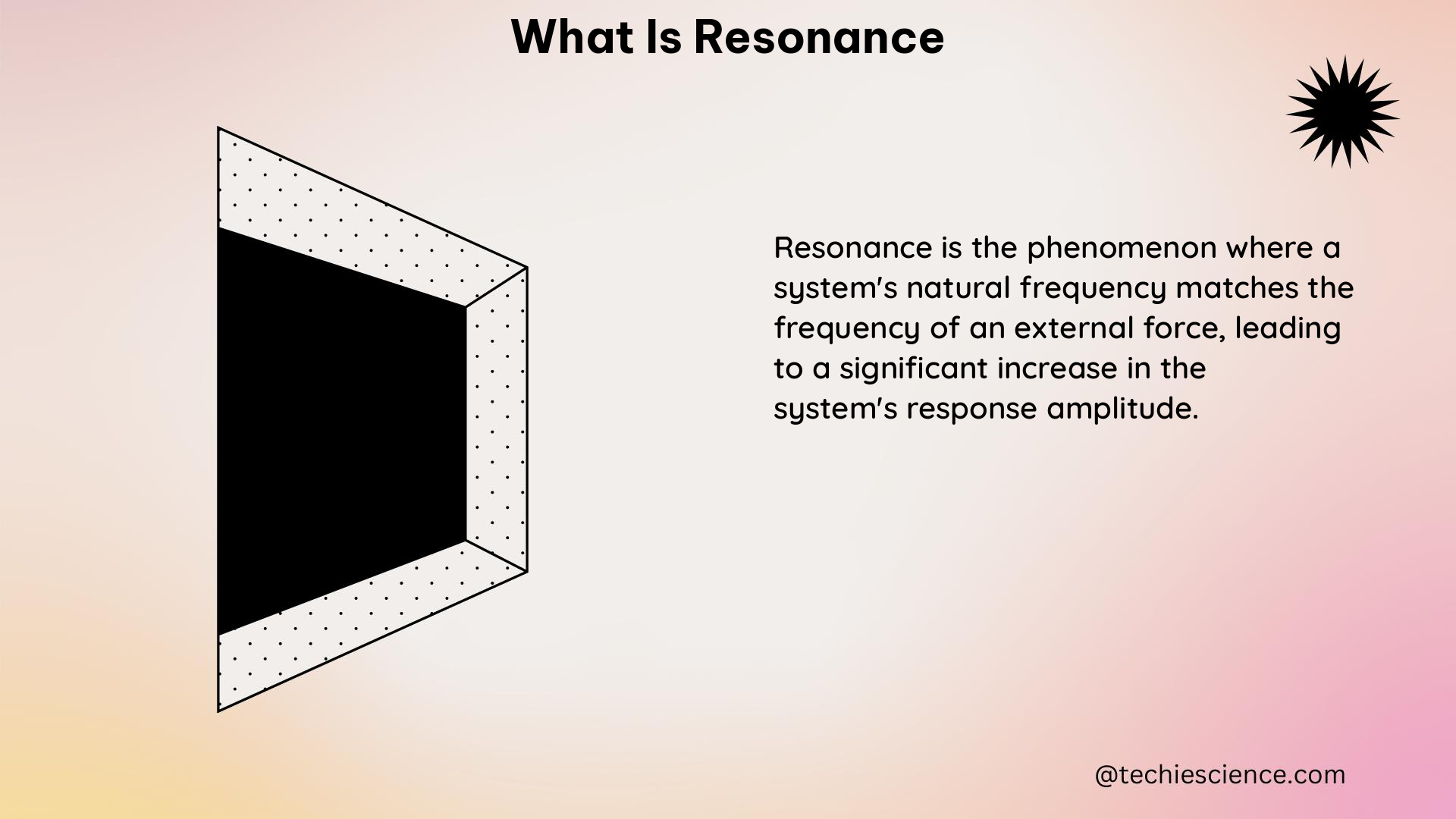Resonance is a fundamental concept in physics and chemistry that describes the phenomenon of oscillations or vibrations in various systems. It occurs when a system is able to store and easily transfer energy between two or more different storage modes, such as kinetic and potential energy. This comprehensive guide will delve into the technical specifications, theorems, formulas, examples, and numerical problems related to resonance, providing a valuable resource for physics students.
Technical Specification of Resonance
Resonant Frequency
The resonant frequency is the natural frequency at which a system tends to vibrate or oscillate. When an external force is applied at this frequency, the system will oscillate at a higher amplitude than at other frequencies. The resonant frequency can be calculated using the formula:
$f_{\text{nat}} = \frac{1}{2\pi}\sqrt{\frac{k}{m}}$
where $k$ is the spring constant and $m$ is the mass of the system.
Gain
The gain is the ratio of the amplitude of the output’s steady-state oscillations to the input’s oscillations. Peaks in the gain at certain frequencies correspond to resonances. The gain can be expressed as:
$G = \frac{A_{\text{out}}}{A_{\text{in}}}$
where $A_{\text{out}}$ is the output amplitude and $A_{\text{in}}$ is the input amplitude.
Linear Systems
Resonance in linear systems is characterized by oscillations around an equilibrium point. The gain can be a function of the frequency of the sinusoidal external input, and peaks in the gain correspond to resonances.
Driven, Damped Harmonic Oscillator
The resonant frequency for a driven, damped harmonic oscillator can be derived using the equation of motion:
$m\frac{d^2x}{dt^2} + b\frac{dx}{dt} + kx = F_0\cos(\omega t)$
where $m$ is the mass, $b$ is the damping coefficient, $k$ is the spring constant, $F_0$ is the amplitude of the driving force, and $\omega$ is the angular frequency of the driving force.
RLC Circuit
An RLC circuit is a classic example of a system that exhibits resonance. The connections between resonance and a system’s transfer function, frequency response, poles, and zeroes can be illustrated using an RLC circuit.
Theorem and Physics Formula

Resonance Condition
The resonance condition is met when the frequency of the external force coincides with the natural frequency of the system:
$f_{\text{ext}} = f_{\text{nat}}$
Damped Harmonic Oscillator
The equation of motion for a driven, damped harmonic oscillator is:
$m\frac{d^2x}{dt^2} + b\frac{dx}{dt} + kx = F_0\cos(\omega t)$
where $m$ is the mass, $b$ is the damping coefficient, $k$ is the spring constant, $F_0$ is the amplitude of the driving force, and $\omega$ is the angular frequency of the driving force.
Examples and Numerical Problems
Simple Harmonic Oscillator
A mass of 0.5 kg is attached to a spring with a spring constant of 100 N/m. If the mass is displaced by 0.1 m and released, what is the resonant frequency of the system?
$f_{\text{nat}} = \frac{1}{2\pi}\sqrt{\frac{k}{m}} = \frac{1}{2\pi}\sqrt{\frac{100\ \text{N/m}}{0.5\ \text{kg}}} = 4.47\ \text{Hz}$
RLC Circuit
An RLC circuit has a resistance of 10 ohms, an inductance of 0.1 henries, and a capacitance of 0.01 farads. What is the resonant frequency of the circuit?
$f_{\text{nat}} = \frac{1}{2\pi\sqrt{LC}} = \frac{1}{2\pi\sqrt{(0.1\ \text{H})(0.01\ \text{F})}} = 159.15\ \text{Hz}$
Figures and Data Points
Resonance in a Mechanical System
Figure 1 illustrates the concept of resonance in a mechanical system. The system oscillates at a higher amplitude when the driving frequency matches the natural frequency.
Gain vs. Frequency
Figure 2 shows the gain of a system as a function of frequency. The peak in the gain corresponds to the resonant frequency.
Measurements and Values
Resonant Frequency of a Guitar String
The resonant frequency of a guitar string can range from 82.4 Hz (E2) to 1046.5 Hz (C6).
Resonant Frequency of a Pendulum
The resonant frequency of a pendulum depends on its length. For a pendulum of length 1 meter, the resonant frequency is approximately 0.5 Hz.
References
- Zurich Instruments Blog: “Resonance Enhancement – A Tale of Two Data Analysis Methods” (2019)
- NCBI Article: “The Easy Part of the Hard Problem: A Resonance Theory of Consciousness” (2019)
- Cambridge Coaching Blog: “An Introduction to Resonance” (2023)
- Wikipedia: “Resonance” (2024)

The lambdageeks.com Core SME Team is a group of experienced subject matter experts from diverse scientific and technical fields including Physics, Chemistry, Technology,Electronics & Electrical Engineering, Automotive, Mechanical Engineering. Our team collaborates to create high-quality, well-researched articles on a wide range of science and technology topics for the lambdageeks.com website.
All Our Senior SME are having more than 7 Years of experience in the respective fields . They are either Working Industry Professionals or assocaited With different Universities. Refer Our Authors Page to get to know About our Core SMEs.